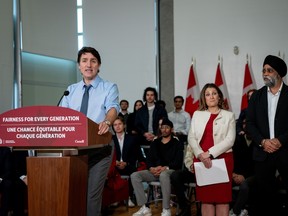[ad_1]
The country appears to be collectively putting on noise-cancelling headphones where the Liberals are concerned.

Article content
Since 2015, Justin Trudeau has been a Pied Piper, playing a tune jaunty enough to make just enough Canadians follow his fiscal path. On the campaign trail that year, after a decade of fiscal austerity under Stephen Harper, Trudeau broke political orthodoxy with a new song: modest deficits and a return to balanced budgets within three years.
It was radical (especially considering the NDP leader of the day was promising to balance his first budget), but 75 per cent of Canadians polled at the time were all in. Trudeau won the election.
Advertisement 2
Article content
Article content
Over the ensuing decade, however, his government has been consistently and increasingly spendy. Granted, if anything called for setting the fiscal taps to full-flow, it was the pandemic years. Even so, the Liberals never did get around to balancing any budgets. In a fiscal update last fall, Finance Minister Chrystia Freeland forecast a budget deficit this year of $40 billion.
If the Trudeau cabinet were to form a band and start a summer music festival, it might be called Spendapalooza. If the prime minister were to moonlight as a DJ, he’d most certainly buy in (fiscally speaking) to the industry adage that if you ain’t redlining, you ain’t headlining.
The thing is, Canadians are looking to shake up their playlists. Data from the Angus Reid Institute has found that even before Trudeau and senior cabinet members spent the first two weeks of April criss-crossing the country with a flurry of big-money spending announcements, three-in-five Canadians (59 per cent) were already saying federal finances had grown too large.
The politics of this sentiment should alarm the governing Liberals. While it’s no surprise nearly nine-in-10 current Conservative Party of Canada voters (87 per cent) say Ottawa is spending “too much,” so too do three-quarters of Bloc Québécois voters, a near plurality of NDP voters (37 per cent), and almost one-in-three current Liberal voters (29 per cent).
Advertisement 3
Article content
This concern is also found among voters who chose the Liberals in 2021, but have since abandoned them. About one-third of those supporters have moved to the CPC and the NDP. Among this group, 47 per cent say Trudeau’s spilling too much red ink.
Those sticking with the government line argue these big-money expenditures are aimed at improving the lives of an aging population (health care: 10 years, $46 billion); lifting children on the economic margins out of poverty and keeping them out, (school food program: five years, $1 billion); or bolstering Canada’s military readiness and prestige among its allies (defence spending: 25 years, $80 billion). Economists also point out that while spending as a percentage of GDP is slightly higher today than it was when the Liberals won power in 2015 (14.6 per cent then, 16.7 per cent now), these values are lower than they were through the ’80s and ’90s.
The problem is that Canadians are at risk of tuning out entirely. The Liberals trail the Conservatives by about 20 percentage points, and rival DJ Pierre Poilievre is tagging Trudeau with a catchier base hook (political slogans) that has the country throwing shapes. For now, it doesn’t seem to matter that the Conservative leader has yet to explain how he’ll dial back spending without hurting the very voters he is wooing.
Advertisement 4
Article content
To get his country back on the dance floor, Trudeau must do three things. First, he must reassure voters this level of spending is sustainable — an increasingly tough case to make as debt becomes more expensive to service, and as those who aren’t members of the loosely defined “middle class” brace for new taxes. Second, he must motivate Canadians about the direct benefits to them from all this spending. This, too, will be difficult given the sometimes decades-long timelines involved from announcement to delivery. And third, he must persuade a sufficient number of Canadians they need to vote Liberal again to keep all the programs they’ve been promised.
At this point, I’m not convinced this government can meet even the first task, let alone the next two. The country appears to be collectively putting on noise-cancelling headphones where the Liberals are concerned. If this continues, it may be Trudeau’s last waltz.
Shachi Kurl is President of the Angus Reid Institute, a national, not-for-profit, non-partisan public opinion research foundation.
Recommended from Editorial
-

Kurl: Should Trudeau rethink his approach to the carbon tax?
-

Federal budget 2024: What Ottawa’s local politicians are looking for
Article content





